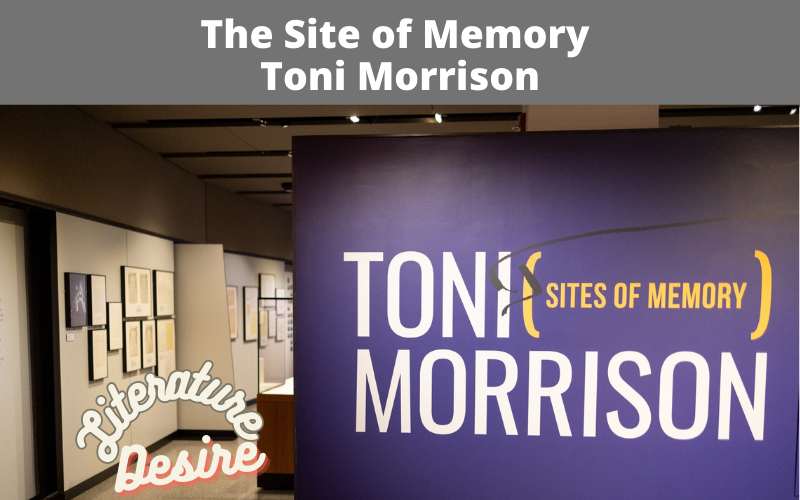This article delves into the significance of the site of memory in the works of Toni Morrison, examining its thematic importance and the profound impact it has on readers.
Toni Morrison, an acclaimed American author, possessed a rare talent for exploring the depths of human experience through her rich and captivating storytelling.
Advertisement
In her works, Morrison masterfully weaves together themes of history, identity, race, and memory, creating a literary landscape that resonates with readers on a profound level. One of the recurring motifs in her writings is the concept of “the site of memory.”
Advertisement
The Site of Memory by Toni Morrison: A Powerful Literary Landscape
Defining the Site of Memory
At its core, the site of memory refers to a place or moment that holds deep personal or collective significance. It represents a reservoir of memories that shape individual and communal identities.
Advertisement
Toni Morrison’s exploration of the site of memory delves into the layers of history, culture, and personal experiences that influence and shape one’s understanding of the world.
Advertisement
The Role of the Site of Memory in Morrison’s Works
In Morrison’s literary universe, the site of memory functions as a powerful tool for storytelling and character development. It serves as a conduit through which the characters navigate their past, confront their present, and envision their future.
By anchoring her narratives in these sites of memory, Morrison brings her readers into a vivid and palpable world, immersing them in the emotions and experiences of her characters.
Unearthing the Buried Past: The Site of Memory Toni Morrison
One of the remarkable aspects of Morrison’s portrayal of the site of memory is her ability to bring to light buried and forgotten histories.
Through her evocative prose, she uncovers the untold stories and experiences of marginalized communities, shedding light on their struggles, resilience, and triumphs.
The site of memory becomes a platform for reclaiming and preserving cultural heritage that might otherwise be erased or ignored.
Reconstructing Personal Narratives
Morrison’s characters often embark on journeys of self-discovery and self-actualization, with the site of memory acting as a catalyst for these transformative experiences.
It becomes a space where characters grapple with their personal narratives, confronts their traumas, and find healing and redemption.
The site of memory allows individuals to reconstruct their identities and reclaim agency over their lives.
Collective Memory and Cultural Identity
Morrison’s exploration of the site of memory extends beyond the individual level and encompasses collective memory and cultural identity.
She delves into the complex interplay between personal and communal histories, highlighting how shared memories shape group consciousness and contribute to the fabric of cultural identity.
By examining the site of memory from this broader perspective, Morrison underscores the importance of acknowledging and honoring collective experiences.
The Site of Memory in Toni Morrison’s Key Works
Beloved: An Unforgettable Encounter
In her Pulitzer Prize-winning novel, “Beloved,” Toni Morrison delves deep into the haunting legacy of slavery and its enduring impact on individuals and communities.
Sethe, the protagonist, is haunted by the memory of her enslaved past, which manifests in the form of a ghostly presence. The site of memory, in this case, becomes a physical space—Sethe’s house—imbued with the weight of history and trauma.
Through Sethe’s journey, Morrison explores the complexities of memory, freedom, and the indomitable power of love.
Song of Solomon: Soaring on the Wings of History
In “Song of Solomon,” Morrison takes her readers on an epic journey that spans generations, exploring themes of ancestral heritage, self-discovery, and the search for identity.
The site of memory in this novel encompasses a rich tapestry of family stories, songs, and legends passed down through generations. It becomes a vital link connecting the characters to their roots and allowing them to transcend societal limitations.
Jazz: The Rhythm of Memory: The Site of Memory Toni Morrison
In “Jazz,” Morrison employs a lyrical and improvisational narrative style to paint a vibrant portrait of the Harlem Renaissance era. The site of memory in this novel is the city itself—Harlem—an epicenter of African American culture and creativity.
Through the interplay of multiple perspectives and fragmented storytelling, Morrison captures the essence of a time and place while exploring themes of love, desire, and the complexities of human relationships.
Conclusion
Toni Morrison’s exploration of the site of memory in her works is a testament to her prowess as a storyteller and her deep understanding of the human experience.
Through her evocative narratives, she invites readers to delve into the layers of memory, history, and identity, urging us to confront the past, embrace our complexities, and shape a more inclusive future.
The site of memory continues to resonate with readers, reminding us of the transformative power of literature and the enduring legacy of Toni Morrison’s extraordinary body of work.
Frequently Asked Questions
The site of memory holds immense thematic importance in Morrison’s works as it serves as a gateway to exploring personal and collective histories, reconstructing identities, and unearthing marginalized narratives.
By anchoring her characters in specific sites of memory, Morrison provides a rich context for their experiences, enabling readers to empathize with their struggles, aspirations, and transformations.
The site of memory becomes a crucial platform for reclaiming and preserving cultural heritage by unearthing buried histories, highlighting marginalized experiences, and emphasizing the importance of collective memory.
Morrison’s portrayal of the site of memory prompts readers to question dominant narratives and consider alternative perspectives, fostering a more nuanced and comprehensive understanding of history.

